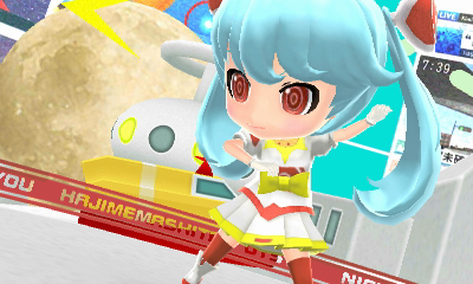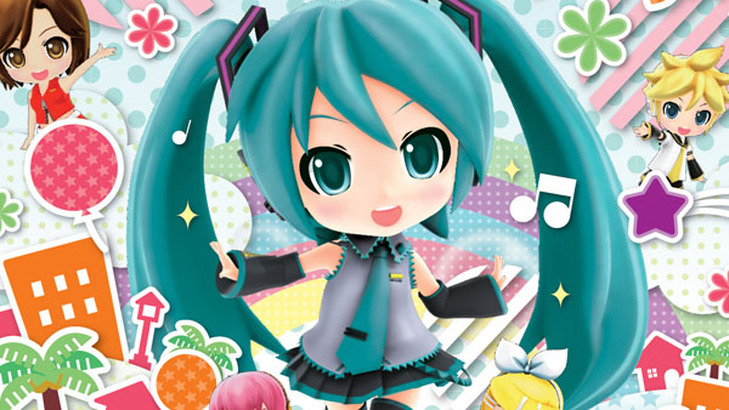|
Just to clarify: no, this does not mean Hatsune Miku is playable in Super Smash Bros. for 3DS and Wii U. However, it does mean that Hatsune Miku is making her Western Nintendo debut on the 3DS with Project Mirai DX! Is Hatsune Miku ready for her overseas Nintendo 3DS run? Or should this game have stayed in Japan? Let’s find out. The most important thing to know about Hatsune Miku is that she is a Vocaloid, which is synthesizer-based software that creates the "voices" of said Vocaloids using prerecorded samples. Whenever you hear Hatsune Miku singing, that’s the software creating the voice via a complex system of pre-programmed input sequences. Think of it like playing a piano or a guitar, except with Hatsune Miku’s voice as the instrument. That’s the best way I can explain it…but I digress. This game has a variety of Vocaloids besides Hatsune Miku like Kagamine Rin, KAITO, and Megurine Luka, and each Vocaloid has their own set of songs. As to the song style, Vocaloid-based music ranges from J-Pop, happy hardcore, and even occasional samba and marching music to change things up a bit. I will say this: the music in general is an acquired taste. It isn’t meant for everyone, so please keep that in mind. It is worth giving a try if you approach it with an open mind. Let’s say that you do enjoy some of Hatsune Miku’s hits and have been a fan for years. The soundtrack in general is a good package; there are some of the more famous songs to play, such as “Senbonzakura” and “World is Mine” amongst others. The nice thing about games like these is that you may discover a song that you don't want to stop playing. In my case, that has been “Clover Club” and “Tricolore Airline”, two amazing songs that I don’t mind playing repeatedly. Give this game a try and you may discover a few new Vocaloid songs too! As for the gameplay, the concept is similar to most rhythm music games: hit the notes or buttons in time with the music. The concept is simple: hit the right buttons following a linear pattern as the song goes. This game differs from the Project Diva games via arcade/PlayStation 3/PlayStation Vita, where the notes hit you on all directions. There are two ways to play the core game. One is with the traditional A-B-X-Y button layout, with the occasional D-Pad button thrown in if you play on harder difficulty levels. Another uses the 3DS stylus pen to tap the notes, as well as swipe in certain directions if prompted. While the 3DS may not recognize some swipes, both gameplay options are still pretty fun, especially when you try to hit notes to the beat of Vocaloid songs. The only gripe about the gameplay is the difficulty level. Now, if you have never played Project Diva on an arcade machine or the PlayStation 3, this is a good “gateway game” for you. Easy of course remains relatively simple, medium will have a few challenging areas and hard tests your knowledge of the 3DS as a controller. However, if you have played Project Diva before on a difficulty other than easy or medium, this game will be too easy for you. Only a few songs, such as “Matryoshka” provide a challenge, but more than half the setlist can be passed on hard if you’ve had experience with Project Diva. The only real test is that trying to full combo a few songs on hard can be a challenge. The game is rather strict on recognizing when you have to press X or A when prompted to. Basically, it’s easy to pass songs, but hard to full combo them.  Other than the rhythm game section, there’s still a lot more to do. There’s a sort of “dating sim”-esque feature you have when you pick out a Vocaloid. You can dress him or her up in outfits found through the songs you play, you can decorate the apartment they live in with all sorts of decorations, and you can play mini games with him or her (such as Reversi, appropriately titled “Mikuversi”). You can use an in-game Vocaloid synthesizer to create songs with a piano, a keyboard, or even your Vocaloid’s voice, for example. There’s also a feature where you can customize your own dance routine and have your Vocaloid perform it during one of the songs you play. You can even listen to the songs in game while playing minigames, and even watch the dance routines found during the rhythm game section. Also included in the package is a vintage SEGA puzzle minigame, Puyo Puyo 39, the latest Puyo Puyo release in 11 years. The concept of this mini-game is simple: match 4 colors in a row, and the more colors you match in a combo setting, the more that hurts your opponent. Fill up your opponent’s section to the very top and you win. This is a fantastic addition to a game already packed with content, and it even provides a challenge when you want to take a break from the rhythm game. Overall, this is a fantastic package for those of you who want to give the first 3DS game featuring Hatsune Miku and pals a try. It certainly won’t provide the most difficult challenge as a game overall, but there’s plenty to do and enjoy with your favorite Vocaloid. I can’t really give a rating system, but what I can say is that it’s a whole lot of fun for someone who has been in the rhythm game genre (i.e. Guitar Hero, Flash Flash Revolution) for several years now. All I can say at the end is that it’s an interesting take on the rhythm game genre and may inspire all sorts of new Hatsune Miku fans far and wide. I still haven’t played through all of it yet, and I feel like this is a game that I won’t put down for a while. Unless there are new downloadable characters in Super Smash Bros. for 3DS of course. -Nathan (L4verra)
0 Comments
|
Search
Contributors◆ Angie
◆ Emily ◆ J.D. ◆ Janette ◆ JT ◆ Manuel ◆ Nestor ◆ Rose ◆ Sylvia ◆ Teepu ◆ Tiffany ◆ Winfield Archives
June 2025
|
© 2014-2025 A-to-J Connections. All Rights Reserved.




 RSS Feed
RSS Feed